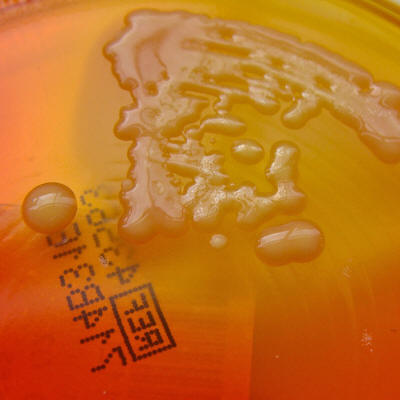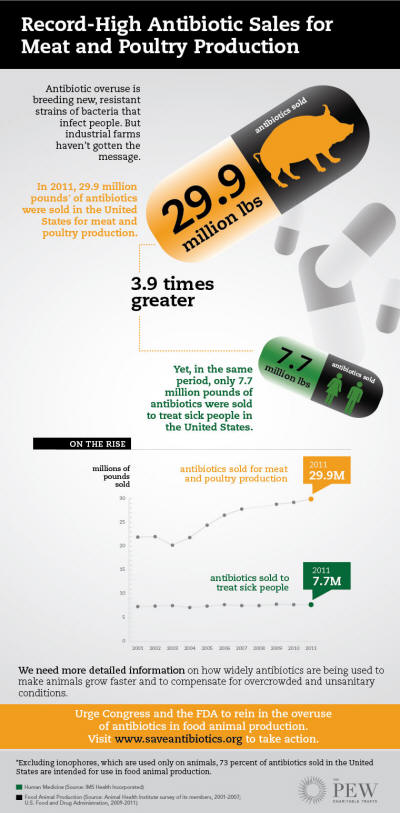|
April 5, 2013
Below you have strong evidence which confirms my statements.
Antibiotics As Prescription Drugs
People became so uncomfortable these days whenever they have a sniffle or infection. They all want it to go away, right away, at any cost! Immediate relief for a life of damaged health.
But common infection doesn't equal antibiotics! Our body simply doesn't work like that.
The whole length of our digestive tract is coated with a bacterial layer providing a natural barrier against invaders, undigested food, toxins and parasites. If this "coating" (mucosal barrier) gets damaged, well… you get the picture!
These beneficial bacteria protecting the gut wall also work against invasive pathogenic micro-organisms by producing antibiotic-like substances, anti-fungal volatiles, anti-viral substances. They engage the immune system to respond appropriately to invaders.
Our healthy indigenous flora has a good ability to neutralize toxic substances from our food and environment, inactivate histamine and chelate heavy metals and other poisons. Again, this is all possible IF the "barrier" is intact…
Without a well functioning gut flora, the gut wall not only becomes unprotected, but also malnourished.
The variety of functions and the essential role of an intact mucosal barrier, a healthy gut flora, make this the root of our health. We simply can not thrive without a healthy digestive system.
What is the clinical reality these days? A vast majority of people have a damaged gut flora and a major culprit to this is: ANTIBIOTICS!
Dr. Natasha Campbell McBride offers a well researched summary of the most common disastrous health effects which directly involve antibiotics :
Since babies are born with a sterile gut flora, the mother essentially "downloads" her gut health / flora into the baby through breastfeeding.
No wonder why digestive problems are usually shown to get worse with each generation, considering the mother's poor gut health and bottle feeding.
Antibiotics In Food
The problem of antibiotics overuse actually grew to proportions because it comes not only from prescription drugs, but from conventional food everywhere as well!
This way, we are exposed indirectly to antibiotics since we are born and their negative effects are real.
Farm animals and poultry are routinely given antibiotics, so all the products made out of these (meat, milk, eggs) will also provide us with a constant supply of antibiotics AND antibiotic resistant bacteria, developed by the animals in their bodies, together with the toxins these bacteria produce.
Many large producers of meat and poultry feed antibiotics to their healthy food animals simply to offset the effects of overcrowding and poor sanitation, as well as to promote faster growth. Every year, nearly 30 million pounds of antibiotics are sold for use in food animals. In fact, up to 70 percent of all antibiotics sold in the United States go to healthy food animals.
Farmed fish and shellfish have antibiotics added, as well as a lot of fruits, vegetables and grains, legumes and nuts, which are sprayed with antibiotics to control disease.
Anti-bacterial Cleaners
Modern times brought along the common belief that everything has to be disinfected and sterilized.
But it's been proven by numerous studies that constant use of conventional sanitizers and antibacterial soaps is also killing the beneficial bacteria existent on our hands, that is meant to actually protect ourselves from disease.
In other words, resistant bacteria - "superbugs" - will develop, and a former common cold will morph into a much more virulent and harder to treat infection.
Facts of Antibiotic Overuse and Solutions to An Imminent Global Danger
Dr. Thomas Frieden, director of the US Centers for Disease Control and Prevention, recently announced the new CDC statistics on the advance of the highly drug-resistant bacteria known as CRE (carbapenem-resistant Enterobacteriaceae).
The reports are frightening:
The U.K.'s Chief Medical Officer, Professor Dame Sally Davies released a report in which she calls resistance a "catastrophic threat" which poses a national security risk as serious as terrorism.
She warns that unless resistance is curbed,
In March 2012, researchers published a report drawing a link between bacteria on chicken and antibiotic-resistant urinary tract infections (UTIs).
They compared E. coli samples from animals in processing plants to the strain of E. coli that causes urinary tract infections and found chicken to be the source of the bacteria.
Last summer, the story gained major traction with the release of a related study by some of the same researchers who found that retail chickens had very high levels of antibiotic-resistant E. coli; about 85 percent of UTI infections came from this E. Coli strain.
Another published study from Germany concluded that methicillin-resistant S. aureus (MRSA) is rarely found in pigs that are raised without antibiotics.
Similarly, the farmers who live and work with these pigs were less likely to have the strain of MRSA commonly associated with livestock than farmers who worked with pigs who were regularly administered antibiotics.
As one of the most notorious multidrug-resistant superbugs, MRSA is responsible for an estimated 19,000 deaths and 360,000 hospitalizations each year in the United States alone.
In September 2012, researchers at Stanford University concluded that consumers eating meat and poultry raised without antibiotics are 33 percent less likely to contract antibiotic-resistant infections than those who eat products raised conventionally.
Considering all this, how can YOU actively participate...in the change of these serious events?
Resources
|


